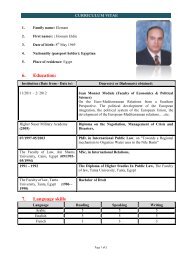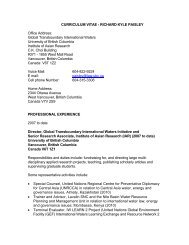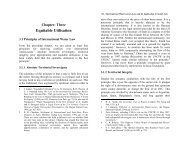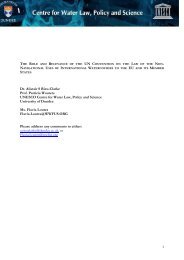Upreti, Trilochan, International Watercourses Law and Its Application ...
Upreti, Trilochan, International Watercourses Law and Its Application ...
Upreti, Trilochan, International Watercourses Law and Its Application ...
Create successful ePaper yourself
Turn your PDF publications into a flip-book with our unique Google optimized e-Paper software.
26 / <strong>International</strong> <strong>Watercourses</strong> <strong>Law</strong> <strong>and</strong> <strong>Its</strong> <strong>Application</strong> in South Asia Development <strong>and</strong> Codification of <strong>International</strong> <strong>Watercourses</strong> <strong>Law</strong> / 27government to resolve the conflict. The facts of the case werethat even after the promulgation of a new constitution of Indiain 1950, the Krishna River Basin was divided among severalstates, due to the high dem<strong>and</strong> of water amongst the contestants(Maharastra, Karnataka, Andhra Pradesh, Madhya Pradesh <strong>and</strong>Orissa). As disputes emerged, eventually, the Krishna disputetribunal was constituted <strong>and</strong> the disputes were referred to it. Itmust be acknowledged here that within Article 262 of theIndian Constitution <strong>and</strong> Inter-State Water Dispute Act, 1956, 29the authority for resolving water disputes between states lies inthe central government <strong>and</strong> the judiciary is excluded from thisjurisdiction:"Under Clause X of the final order of the tribunalpermitted the state of Maharastra to divert the waterof Krishna River for use outside the Krishna Riverbasin but imposed a limit beyond which Maharastacould not divert the said water within one wateryear”….The tribunal maintaining that a river is anindivisible physical unit further stressed that “theconflict of interests of the riparian states must beresolved by agreement, judicial decree, legislation oradministrative control, so as to secure a fair <strong>and</strong> justdistribution of the water resources among theconcerned states." 30In brief, this decision calls for a co-ordinated, participatory <strong>and</strong>equal entitlement in the use of a common river to all riparianstates.29 Ibid. p. 169: Dispute relating to Waters: “(1) Parliament may by lawprovide for the adjudication of any dispute or complaint with respect tothe use, distribution or control of the waters of, or in, any inter-stateriver or river valley. (2) Notwithst<strong>and</strong>ing anything in this Constitution,Parliament may by law provide that neither the Supreme Court nor anyother court shall exercise jurisdiction in respect of any such dispute orcomplaint as is referred to in clause (1).”30 Ibid. pp . 229-231.The issue of diversion was dealt with in the Narmada RiverWater Dispute, 1978 31 in which four states, Madhya Pradesh,Rajasthan, Maharastrra <strong>and</strong> Gujarat were contestant parties.The Narmada Water Tribunal was constituted <strong>and</strong> the disputereferred to it. In its decision, the tribunal quoted the findings ofthe Indus Commission (the Rau Commission dealt with below)<strong>and</strong> Articles IV <strong>and</strong> V of the Helsinki Rules 1966, <strong>and</strong> held theview that equitable apportionment is the appropriate rule inadjudicating a dispute like this. It also observed that:“the diversion of water of an inter-state river,outside the river basin is legal <strong>and</strong> the need fordiversion of water to another watershed may,therefore, be a relevant factor on the question ofequitable apportionment in the circumstances of aparticular case. … the question of diversion ofwater of an inter-state river to areas outside thebasin is not a question of law but is a question offact to be determined in the circumstances of eachparticular case”. 32The ruling explicitly relied on the principles of equitableapportionment <strong>and</strong> directed the parties to establish an entity inorder to implement the project <strong>and</strong> consent to intra-basintransfer of waters.In the Godawari River Water Dispute, 1980, 33 the disputantstates were Maharastra, Andhra Pradesh (AP), Karnataka,Madhya Pradesh <strong>and</strong> Orissa <strong>and</strong> the conflict was over sharingof water. With regard to the question of whether it was lawfulfor the state of AP to execute a project that was likely tosubmerge the territories of the other states, the tribunal held theview that 'it is to be observed that each case of possible31 Ibid. pp.244-250; also see Report of the Narmada Water DisputeTribunal, Vol. 1, 1978, p. 2532 Ibid.33 Ibid. p. 265; also see Report of the Godawari Water Dispute Tribunal,Vol. 1, 1979.












